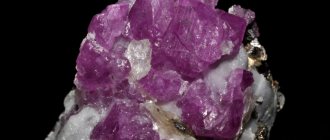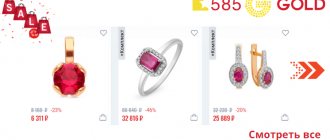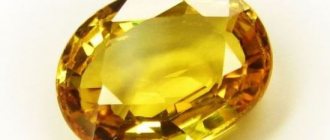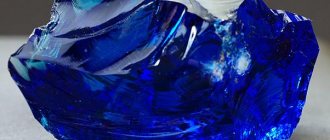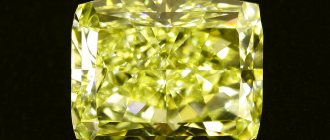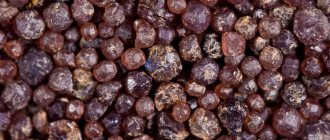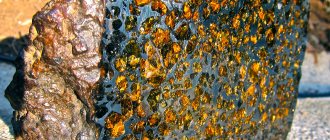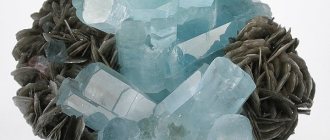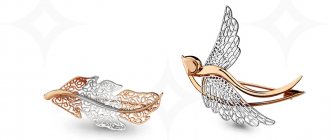origin of name
The name presumably comes from the Indian name for the mineral Kauruntaka, introduced into mineralogy by Greville (1798).
Synonyms: Adamas - adanias (Pliny; diamond was also mentioned in ancient times under the name adamas), demantspat - Demantspat (Klaproth, 1786), soimonite - soimonite (Fuchs, 1823), harmophane - harmophane (according to Chester, 1896), corunduvite - korunduvite ( Ascenzo, 1945).
The English name for the mineral Corundum is Corundum.
Group
Corundum
Description of corundum
Natural corundum has a transparent structure with a metallic or glassy luster.
Corundum is a mineral with a crystalline structure of alpha aluminum oxide. It is found in nature in the form of pyramids, prisms and barrels. It is considered a gemstone of the highest category. Due to the structure of the crystal lattice, its hardness is second only to diamond and is widely used not only in jewelry, but also in optics, microelectronics and other mechanical industries.
The stone has high transparency, luxurious shine and bright color, but cloudy specimens are more common.
Application of corundum
The applications of corundum differ depending on the physical characteristics and appearance of the mineral. The best samples are used in jewelry. They are inserted into various jewelry - earrings, pendants, bracelets, rings, brooches. Men can choose cufflinks, tie clips or rings with this mineral.
Note! Synthetic items in 925 sterling silver or 585 gold are considered a generally available option for jewelry. Luxury products include natural stones combined with gold or platinum.
To make corundum in jewelry look attractive, you should choose it correctly and combine it with other jewelry:
- Corundum is recommended to be worn with minerals of the same level. Combining it with jasper, malachite, coral or other similar stones is considered bad form.
- The younger the woman, the lighter and smaller stones will suit her. Young girls should give preference to pink or blue corundum. For mature women, deep blue or purple shades are suitable.
- To make the mineral the accent of your look, you should give preference to a modest frame. It is best to use silver as a complement.
- It is recommended to combine such jewelry only with high-quality branded clothing. Sports style items will look out of place in this case.
In general, corundums can be combined with different minerals. It is worth considering their shade. So, sapphire corundum looks great with alexandrite. Transparent types look good with a variety of stones. Combinations with semi-precious minerals are also acceptable.
At the same time, synthetic corundum can be used in other areas. Durable raw materials are often used in industry:
- As an abrasive in sharpening machines. In some cases, it simply performs the functions of a sharpening stone or ordinary sandpaper.
- For the manufacture of products for radio electronics and precision engineering. The material is used to produce lasers, medical instruments, and drilling rig parts.
- For the manufacture of parts for rockets, aircraft and mobile gadgets. Glass elements are made from artificial sapphire.
- For the production of luxury wristwatch parts.
- As thermal insulation. A layer of corundum 1 mm thick is comparable to 50 mm of mineral wool.
- As a grinding paste.
Origin story
Corundum has been known since the times of Ancient Egypt and Judea. Mentions of it can be found in ancient texts: it was used to decorate the robes of priests and high priests.
Corundum came to Europe from India, but the name, which has Sanskrit roots, did not take root. Precious stones, which have a common name in the East, were united in the Old World only in the 19th century.
In Russia, the stone has been known since ancient times. Under the name "yakhont" he often appeared in folk art. Researchers are sure that in Rus' this stone was mined independently, although there are hypotheses that it was brought from the East along the Silk Road.
Deposits and stone mining
Corundum forms where igneous rock comes to the surface or in underground air cavities rich in aluminum. It is formed under pressure and high temperatures over thousands of years. Most often, stones can be found in mountain ranges in the form of rare inclusions, so their extraction from the rock is impractical.
There are only a few rich deposits of corundum - terrestrial alluvial rocks. Over millions of years, the mountain range is gradually destroyed, its rock falls into rivers and is polished by water. The hardest particles - rubies, sapphires - are not destroyed and remain in the riverbed at a depth of half a meter. They are removed by washing and digging up the soil in those places where accumulations have formed.
Blue minerals are less common in nature than red ones.
This is how corundum is mined in Thailand, Sri Lanka, Burma and Tanzania. Clusters of blue minerals are more common in rocks and are periodically mined directly from the veins. For example, Kashmir dark blue sapphires are being mined in mines in the Himalayas. Less significant deposits of jewelry stones are located in Madagascar, Myanmar, Russia, Greece, Norway, Australia, Brazil, Canada and the USA.
Corundum-ilmenite group
In addition to dimorphic oxides of the A2X3 type (Al2O3, Fe2O3), this, according to X-ray data, should also include complex (double) oxides of the ABX3 type (where A = Mg, Fe••, Mn•• and B = Ti), crystallizing in a lattice of the type corundum It is characteristic that Fe2O3 with Fe••TiO3 at high temperatures forms a continuous series of solid solutions that decompose upon cooling.
All minerals of this group crystallize in the trigonal system and have the same type of crystal structures (Al2O3 type). Only Fe2O3 under natural conditions is found in two modifications: α-Fe2O3 - trigonal system and γ-Fe2O3 - cubic. The symmetry of double oxides like FeTiO3 is lower compared to simple oxides like Fe2O3, since their cations are not equivalent. They are formed under conditions of relatively high temperatures.
Corundum
— Al2O3. The name of the mineral was given in India. The following polymorphic modifications are known for Al2O3:
- 1) α-Al2O3 (corundum) - trigonal, the most stable in natural conditions; formed in a wide temperature range (500-1500°);
- 2) β-Al2O3 - hexagonal, stable at very high temperatures; the transformation of α-Al2O3 into β-Al2O3 occurs at temperatures of 1500-1800°; this modification is formed during very slow cooling of the Al2O3 melt;
- 3) γ-Al2O3 - cubic, with a spinel-type crystal lattice (the same as we have for maghemite); obtained artificially by calcination of aluminum oxide hydrate (boehmite) at temperatures below 950°; at higher temperatures it is not stable - it turns into α-Al2O3.
Chemical composition
. A1 53.2%, O 46.8%. Crystalline varieties are exceptionally pure in composition. Insignificant impurities of Cr cause red, Fe••• - brown (in a mixture with Mn) and pink, Ti - blue, a mixture of Fe•• and Fe••• - black color.
Rice. 145. Crystal lattice of corundum, depicted in the form of Al2O3 groups
singonia
trigonal;
ditrigonal scalenohedral v.s. L633L23PC. The crystal structure
of Al2O3 is shown in Fig. 145 in the form of Al2O3 groups at the corners of two rhombohedrons that make up the unit cell. Despite its apparent complexity, it has a fairly simple structural diagram. Oxygen ions are in a dense hexagonal packing and are arranged in sheets perpendicular to the triple axis (Fig. 146), superimposed on one another. Al cations are located between two such sheets in the form of hexagons (with an unoccupied center), filling two-thirds of the octahedral voids (i.e., the voids between six oxygen anions, three of which belong to one, and the other three, rotated relative to the first by 180°, - another sheet of oxygen ions). In this case, the groups of every three oxygen ions form a common face for two adjacent octahedra in adjacent sheets. It is characteristic that the oxygen sheets are superimposed on each other in such a way that in each column of octahedra two occupied ones also alternate with one unoccupied one, and the pairs of occupied octahedra form helical triple axes vertically.
Rice. 146. Two layers of dense packing of oxygen anions with aluminum cations (in octahedral voids) in projection onto the (0001) plane. In a hexagonal cell, six Al-O layers are located one above the other. The Al2O3 group is shown at the top (in profile)
Crystal Appearance
. Usually, fairly well-formed barrel-shaped, columnar, pyramidal and lamellar crystals are observed, sometimes reaching large sizes (up to a decimeter in diameter). The most common faces are the ditrigonal prism {1120}, ditrigonal dipyramids {2241}, {2243}, rhombohedron {1011} and pinacoid {0001} (Fig. 147). Often the faces of prisms and dipyramids, as well as the faces of the pinacoid, are covered with oblique shading.
Rice. 147. Corundum crystals
In other cases, hatching in the horizontal direction is observed due to twinning along the pinacoid. Corundum is usually disseminated into the rock, but there are known deposits where it forms continuous granular masses.
Color
corundum is usually bluish or yellowish-gray (for cloudy translucent varieties). Transparent crystals of various colors are found. Varieties of transparent precious corundums:
- leucosapphire
- colorless, - sapphire
- blue, - ruby
- red, - “oriental topaz” - yellow,
- “eastern amethyst” - purple,
- “oriental emerald” - green,
- “star-shaped corundum”, which has asterism when viewed in the light (in the plane of the basopinacoid, opalescence in the shape of a six-rayed star is observed, running when turning, due to oriented microscopic inclusions of mechanical impurities).
Shine
glass. Nm = l.767 and Np = 1.759.
Hardness
9.
Cleavage
is practically absent.
Only separation is observed along the pinacoid, sometimes along the main rhombohedron (due to polysynthetic twinning). Ud.
weight 3.95-4.10. The melting point of artificial corundum is 2040°.
Diagnostic signs
. Easily recognized by the shape of the crystals, shading on the edges, often characteristic bluish-gray color and high hardness. It differs from similar disthene (Al2SiO5) in the absence of perfect cleavage and high hardness. Ruby can be distinguished from red spinel by the shape of its crystals, and in irregular grains - only under a microscope. P. p. tr. doesn't melt. Does not dissolve in acids.
Origin
.
Sometimes found in alumina-rich and silica-poor deep igneous
rocks - corundum syenites and anorthosites in association with feldspars, occasionally in other rocks (andesites, basalts, etc.).
pegmatites
are also known .
Contact-metasomatic
Corundum deposits are formed in crystalline limestones adjacent to igneous rocks. Here it is often represented by precious varieties (ruby, sapphire, etc.). In some cases, its deposits arise due to the sharp impact of pneumatolytic agents on aluminous sedimentary and igneous rocks. In these cases, corundum is associated with minerals such as andalusite, sillimanite, as well as rutile, diaspores, etc.
Corundum rocks can also form as a result of regional metamorphism
out of direct connection with igneous rocks. The rocks usually turn into crystalline schists.
Being a chemically very stable mineral, it is often found in placers
.
During hydrothermal processes, previously formed corundum sometimes undergoes hydration, i.e., transformation into diaspores (HAlO2). Under surface conditions this phenomenon is not observed, with rare dubious exceptions.
Practical significance
. Corundum, which has high hardness, is mainly used as an abrasive material. For this purpose, corundum grinding wheels, discs, sandpapers and powders (“minute grinders”) are made from it, used in grinding and polishing various products (mainly in the metalworking industry). Transparent colored varieties are used as precious stones in jewelry.
Recently, in a number of countries with cheap electricity, they began to prepare artificial corundum (alundum) by electric smelting of alumina-rich rocks, in particular bauxite. Artificial corundum has advantages over natural corundum - purity and coarse grain size. In special furnaces, by fusing Al2O3 powder with 2.5% Cr2O3, rubies are obtained that are identical to natural ones, and with Ti and also with Co-sapphires.
Place of Birth
.
In the USSR, the most interesting deposit of high-quality corundum raw materials, Semiz-Bugu,
is located in the Bayan-Aul region of Kazakhstan (320 km southwest of Pavlodar).
Nest-shaped ore bodies here are composed of almost continuous granular corundum of a dark blue or gray color. They are separated from the host quartzites by zones of andalusite rock. Muscovite, in some places hematite, rutile, diaspores and other minerals are paragenetically associated with corundum. A number of corundum deposits are known on the eastern slope of the Urals - in the Kyshtym region, in the upper reaches of the river. Borzovki
, in the form of corundum plagioclase veins among ultrabasic rocks, along the eastern shore of the lake. Irtyash, where among metamorphic rocks, in particular marbles, there are lens-shaped and irregularly shaped emery bodies containing chloritoids and sulfides.
Of the foreign deposits, deposits of precious transparent corundum (ruby and sapphire) are very famous in India: in Upper Burma
(in the contact zone of marbles with granites), in
Siam
(in placers, mainly sapphire), etc.
Hematite
-α-Fe2O3. The name comes from the Greek word “gematikos” - bloody. In nature, two polymorphic modifications of iron oxide are known: α-Fe2O3 - trigonal, stable and γ-Fe2O3 - cubic, unstable, which we will consider separately. Synonyms: iron luster, iron mica, red iron ore (dense cryptocrystalline variety), iron sour cream (red powdery variety). Martite is a pseudomorph of hematite based on magnetite.
Chemical composition
. Fe 70.0%, O 30.0%. Sometimes Ti (titanhematite) and Mg are present as isomorphic impurities. Water (hydrohematite, usually found in colloform form) is also found in small quantities. In cryptocrystalline dense masses, the presence of silica and alumina in the form of mechanical impurities is often established.
Rice. 148. Hematite crystals n {2243}, r {1011}, c {0001}
singonia
trigonal;
ditrigonal-scalenohedral c. With. L633L2PC. The crystal structure
is similar to that of corundum (see Fig. 145).
The appearance of crystals
.
Relatively common in lamellar, rhombohedral and tabular crystals (Fig. 148), formed in voids. Common shapes are: rhombohedrons {1011}, {1014}, pinacoid {0001}, ditrigonal scalenohedron {2243}, etc. Due to the formation of polysynthetic twins along the rhombohedron {1011}, the pinacoid planes, like those of corundum, are covered with triangular hatching (Fig. . 148), and the planes of the rhombohedron {1011} - with parallel diagonal hatching. Simple twins are rarely observed, mainly along the rhombohedron and also along the prism. Original clusters of slightly curved lamellar crystals are known, fused along planes close to the position of the pinacoid (the so-called “iron roses”). Aggregates
. Often found in continuous dense cryptocrystalline masses, leafy or scaly aggregates. Large kidney-shaped forms with a radial fibrous structure are called “red glass heads” (see Fig. 45). In very many cases, finely atomized anhydrous iron oxide in individual minerals and rocks gives them an intense red color. These are, for example, wax-red jaspers (siliceous rocks), red marbles, red shales.
Color
The crystalline varieties of hematite are iron-black to steel-gray.
In the thinnest plates it shines through with a deep red color. The earthy, atomized varieties have a bright red color. The streak
is cherry red.
luster
. Sometimes a bluish discoloration is observed. Translucent only in very thin plates. Nm = 3.01 and Np = 2.78 (for Li-light).
Hardness
5.5-6.
Fragile. cleavage
.
Characteristic is rough separation along the {1011} rhombohedron. Ud.
weight 5.0-5.3.
Diagnostic signs
. It is quite easily distinguished from similar minerals (ilmenite, magnetite, goethite, bournonite, etc.) by its cherry-red streak, high hardness, lamellar or scaly aggregates, and lack of magnetism.
P. p. tr. doesn't melt. It is characteristic that in a reducing flame at high temperatures it becomes magnetic (turns into magnetite). Very slowly soluble in HCl.
Origin
. Hematite forms under oxidizing conditions in a wide variety of genetic types of deposits and rocks. Formation temperatures can vary widely, but it is not stable at high temperatures.
As a component in very small quantities it is sometimes present in igneous
rocks, mainly acidic (granites, syenites, andesites, etc.). It is also relatively rare in pegmatites as a mineral formed during the hydrothermal phase of the process.
In some hydrothermal
in deposits it is found in significant masses in association with quartz, barite, sometimes magnetite, siderite, chlorite and other minerals. The phenomena of its later reduction to magnetite are observed quite often. However, in other places the reverse process is established - the transformation of magnetite into hematite (martitization process). Obviously, these phenomena are associated with a change in the redox potential after the deposition of these minerals from hydrothermal solutions.
As a product of volcanic exhalations
, usually in small quantities, is found in the form of crystals and deposits on the walls of volcanic craters and in lava fissures. In 1817, on Vesuvius, a mass of hematite about 1 m thick was deposited in one of the cracks within 10 days in this way. In all likelihood, it is the result of the decomposition of volatile ferric chloride compounds.
In the weathering crust
, in dry, hot climates, hematite and hydrohematite arise as a result of dehydration of the initially formed iron hydroxides. This irreversible transition is easily proven artificially by gradual dehydration of goethite. Often these minerals are associated with aluminum hydroxides - diaspore and boehmite (in ferruginous bright red bauxites).
Hematite-hydrohematite formations of a sintered form (“red glass head”) are known, which have a concentric shell-like structure and a splintered fracture. Individual concentric zones consist of radial fibrous masses of hematite, hydrohematite, and sometimes goethite. The conditions for their formation have not been sufficiently studied. They are probably a product of dehydration of similar shaped brown iron ores.
Finally, it should be pointed out that in countries with a hot climate, in the upper zones of magnetite deposits, martitization is often widely manifested, i.e., the oxidation of magnetite masses with their transformation into hematite masses according to the reaction: 4 Fe3O4 + O2 = 6Fe2O3.
During processes of regional metamorphism
, under conditions of elevated temperature and elevated pressure, hematite often appears in very large masses due to sedimentary deposits of brown iron ores through their dehydration. These are, in particular, oolitic red ironstones, shales with iron mica and ferruginous quartzites, consisting of layers of quartzite interspersed with layers of fine-flaky dense hematite. Such quartzites sometimes contain huge bodies of hematite-magnetite solid ores.
Hematite, as a higher iron oxide, is a chemically resistant mineral in the oxidation zone. Sometimes only the phenomena of physical weathering (disaggregation) of hematite masses with the formation of “iron sour cream” are observed. The transformation of its crystalline varieties into hydroxides is established extremely rarely, and, moreover, under very special conditions and on a very small scale.
Practical significance
. Hematite ores are among the most important iron ores from which cast iron and steel are smelted. Their importance in the national economy and industry is well known. The iron content of solid hematite ores typically ranges from 50 to 65%. Pure varieties of powdered hematite are used as paints and for making red pencils.
Place of Birth
.
In the USSR, the largest deposits of high-quality hematite-magnetite ores are located in Krivoy Rog
(Ukraine) in Precambrian ferruginous quartzites, which are the result of regional metamorphism of initially sedimentary ferruginous strata, repeatedly assembled into steep folds.
An example of hydrothermal deposits is Kutimskoye
(N. Urals), the ores of which occur in Paleozoic dolomites and are represented by crystalline masses of large-plate hematite, in places transformed into magnetite.
Oolitic red iron ores in the form of sheet deposits are common on the western slope of the Middle Urals - in the Kusye-Alexandrovsky
and
Pashiysky
regions.
Martite ores are found in significant quantities in the upper zones of a number of large magnetite deposits in the Urals: on the Magnitnaya
,
Vysokaya
(near the city of Nizhny Tagil) mountains, etc.
Among the deposits outside the USSR, we note the largest deposits in Precambrian metamorphosed strata in the area of Lake Superior
(USA) and
Minas Gerais
(Brazil).
Of great mineralogical interest is the contact-pneumatolyte deposit on the island. Elbe
, where the remarkable crystals of iron luster come from, exhibited in many mineralogical museums. Iron roses are found in a number of places in the Alps (St. Gotthard, etc.).
Ilmenite
— FeTiO3, or FeO-TiO2. The name comes from the Ilmen Mountains (Southern Urals), where it was first installed. Synonym: titanium iron ore.
Chemical composition
. Fe 36.8%, Ti 31.6%, 0 31.6%. It may contain as isomorphic impurities: Mg, often in significant quantities (picroilmenite); sometimes Mn (up to several percent). There is a continuous isomorphic series FeTiO3 - MgTiO3 and, probably, a series FeTiO3 - MnTiO3.
Rice. 149. Ilmenite crystal c {0001}, n {2043}, g {1011}
singonia
trigonal;
rhombohedral c. With. L63C. The crystal structure
is similar to the structure of corundum, with the only difference being that the Al sites are alternately occupied by Fe2+ and Ti4+.
Such replacement by dissimilar ions leads to a decrease in the symmetry of the crystal lattice. The appearance of the crystals
is thick-tabular (Fig. 149), rhombohedral, sometimes lamellar. The following forms are most often observed: pinacoid {0001}, rhombohedra {1011}, {0221}, {2243}, etc. Twins along the rhombohedron {1011}. Usually found in the form of interspersed grains of irregular shape, rarely in continuous granular masses. Under the microscope, ilmenite in the form of lamellar precipitates is found in some varieties of hematite as a product of the decomposition of solid solutions, but much more often it is observed in the so-called and occasionally in some titanium varieties of augites and other minerals, also as a product of the decomposition of solid solutions.
Color
ilmenite is iron-black or steel-gray.
The line
is mostly black, sometimes brown or brownish-red (for varieties containing hematite as inclusions).
luster
. Opaque.
Hardness
5-6.
The cleavage
is very imperfect along the rhombohedron {1011}.
Ud.
weight 4.72. Weakly magnetic.
Diagnostic signs
. Similar to hematite. We can distinguish crystals by their shapes (only rhombohedrons are present, there are no faces of scalenohedrons and hexagonal dipyramids). In continuous masses it differs from hematite in its features and weak magnetism.
P. p. tr. doesn't melt. In a reducing flame it becomes clearly magnetic. In powder, it dissolves with difficulty in concentrated HCl with the release of titanium oxide. After fusion with KHSO4, boiling with tin gives a bluish-violet solution, and when diluted with water, pink (reaction to titanium).
Origin
. In the form of dissemination, ilmenite is found in basic igneous rocks (gabbro, diabase, pyroxenite, etc.), often in association with magnetite, as well as in alkaline rocks. It is sometimes observed in significant quantities in certain types of pegmatites (syenite) in paragenesis with feldspars, biotite, ilmenorutile, etc.
In hydrothermally altered igneous rocks, ilmenite is typically observed in a decomposed state, having been converted into what is called leucoxene. There are also cases of decomposition of ilmenite with the formation of a mechanical mixture of hematite and rutile with preservation of the external shape of ilmenite crystals.
Practical significance
. In the case of large accumulations, it can be titanium ore, used in the form of TiO2 as a white paint (titanium white with high covering power), as well as for alloys with iron - ferrotitanium containing 10-15% Ti, for the manufacture of special grades of steel and for other purposes.
Place of Birth
.
In the USSR, ingrown crystals of ilmenite, sometimes of considerable size, are found in pegmatites of the Ilmen
Mountains near the city of Miass (Southern Urals) among nepheline syenites. It is widespread in many deposits in the form of inclusions in titanomagnetites.
Of the foreign deposits, we note the Norwegian ones: Ekersund-Soggendal
in the form of veins in norites (the main igneous rock),
Kragerö
, where large crystals weighing up to 6-7 kg are found, etc.
Types of stone
Types of corundum are distinguished depending on color.
Rubies
Ruby, or red yakhont, is a type of stone with a scarlet color, which is given by impurities of chromium. Transparent rocks are more valuable than diamonds. Burmese rubies are considered the most expensive. They have a rich, deep scarlet hue with a bluish tint - the color of pigeon's blood. Thai stones are distinguished by a light brownish tone - Siamese. Rubies from Sri Lanka are scarlet with a bright crimson tint, and Vietnamese ones are purple.
There is a special type of red yacht with an asterism effect. In another way, this mineral is called star ruby. When light hits the stone, it creates the effect of a star shining inside.
The category of rubies includes primarily stones of a bright red hue.
Sapphires
Sapphire, or azure yakhont, is a precious blue or light blue corundum, colored with titanium atoms. The richest cornflower blue stones from India - Kashmiri - are considered the most valuable. Siamese minerals from Thailand have a greenish tint. Sapphires from Sri Lanka (Ceylon) are light blue with a bluish tint.
In Tanzania, unique stones are mined that change their color depending on the lighting (the so-called alexandrite effect). Shining asterias (star sapphires) and minerals with a cat's eye effect are especially valued by jewelers.
Sapphire is a precious stone that is cheaper than ruby.
Other types
In addition to the familiar rubies and sapphires, there are other types of corundum:
- Padparadscha , which is translated from Sinhala as “lotus color”, is a stone that has an orange-pink color. The iridescence of its shades is poetically called “the color of the sunset tropical sky” or “molten gold.” But this species is valued not only because of its color. Compared to ruby, the mineral is more transparent and has fewer defects. It is believed that real padparadscha is found only in Sri Lanka.
- Green corundums are oriental emeralds, or chlorosapphires, less valuable stones of deep color, sometimes with a yellowish tint.
- Violet - oriental amethysts, iridescent in shades from pink to dark lilac.
- Polychrome sapphires are rare yellow-green, violet-blue or, for example, blue-green corundum. In the structure of the stone, 2 dissimilar colors are visible, which is due to impurities in the rock.
- Leucosapphires , or oriental diamonds, are the rarest varieties. Transparent, with a metallic or glassy sheen, without any color. They are especially highly valued among jewelers because of their uniqueness.
- Emery , or technical muddy corundum, has no jewelry value. Due to its hardness it is used as an abrasive. It can be either white or brown. The first one is looser, but at the same time it is a pure abrasive - it contains 99% Al2O3.
In nature, not only blue and red, but also other varieties of corundum are found.
Physical properties of corundum
Optical
Color varied; the most common is bluish or yellowish-gray (for opaque and translucent varieties); also white to colorless, yellow, violet, red, green, indigo blue, brown, black. Sometimes in daylight blue or green becomes reddish, purple in artificial light; in some cases, blue corundums darken under artificial light. Color is one of the main characteristics by which corundum varieties are distinguished. Crystals with zonal coloring with alternating zones of red, blue or other colors are known; zones parallel to the prism and pyramid were noted. Based on the study of artificial crystals, it was established that in the absence of impurities, corundum is colorless. The admixture of Cr gives corundum a violet-red color, Ni - yellow, V - greenish-gray, Ti and Fe - violet-blue, V and Cr - violet-pink, similar to the color of amethyst.
- Trait . The color of the powder is white.
- The luster is diamond to glassy, sometimes pearlescent on (0001).
- Transparency Usually translucent only in thin fragments; precious varieties are transparent.
Refractive indices
Nm = 1.767 and Np = 1.759.
Mechanical
- Hardness 9. Microhardness 2108 kg/mm2; In artificial corundum rolls, the microhardness is the lowest on the basopinacoid.
- It is fragile and very viscous in fine-grained masses.
- The degree of wear of corundum (sapphire, ruby) is different on different faces and significantly depends on the direction.
- Density. 3.95—4.4
- There is no cleavage; The separation by (0001) and (1011) is sometimes good, and occasionally by the prism.
- The fracture is uneven to conchoidal.
- It splits quite easily along individual planes.
Areas of application
Corundum is a mineral that is widely used in various industries - from making jewelry to making microcircuits.
Jewelry
Precious transparent rocks are valued by jewelers from all countries. Rubies and sapphires are cut to increase dispersion and light refraction. Most often, white, yellow or red gold is chosen as a setting for natural gems.
Corundums are suitable for making any types of jewelry: pendants, earrings, necklaces, rings. Products with rubies and sapphires always look luxurious and attract admiring glances.
In addition, boxes, bracelets, watches and other luxury items are inlaid with stones.
Other areas
The areas of application of corundum are different:
- Collecting - corundums, unique in their structure, color or size, become the crown of a collection of precious minerals.
- Processing of materials - until the twentieth century. cloudy gem samples were used as abrasives: for grinding, processing and cutting. Now artificial stone is grown for these purposes.
- Sound recording - synthetic corundum is used to cut lamellas on vinyl records.
- Technical area - stones are used as bearings in high-precision and complex computing mechanisms: watches, scales, etc.
- Laser production - ruby rods are used in pointers, in scanners for reading barcodes, for cutting and welding, as well as for creating profile optical devices.
- Glassmaking - high-strength sapphire crystals are made for watches, telephones, airplane windows and even spaceships.
Application of stone
Natural and synthetic corundum is used not only for medicinal purposes, but also as amulets. It is also used to make ophthalmic instruments, which are used in operations involving the replacement of the eye lens. They also make chemically inert prostheses and implants from the mineral that do not provoke a rejection reaction.
The characteristics of the nugget are used in the radio-electronic industry; the mineral is used as a worthy, high-strength alternative to ordinary glass. Crystals are used in the manufacture of smartphones and cameras, windows of spaceships and airplanes, and in watches.
Corundum is indispensable in industry: it is used to make an abrasive (crushed into powder). For polishing, “diamond spar” is used from crushed crystal mined in India. This material is in demand in the production of bearings and other moving parts; it is used in high-precision instruments and watch mechanisms.
Physicochemical characteristics
The main properties by which corundum is distinguished from other minerals:
- strength on the Mohs scale - from 8.5 points;
- density per 1 cm³ - about 4 g;
- trigonal system and lack of cleavage - high purity;
- crystal structure - when a ray of light is directed at a stone, it is refracted into many rays;
- glass diamond luster;
- resistance to high temperatures - melts at +2050 ⁰С;
- resistance to chemical and mechanical influences.
physical characteristics
Corundum is a stone from the category of ornamental and precious minerals. Their origin is associated with crystallized alumina. The mineral is characterized by high strength. According to this indicator, it is inferior exclusively to diamonds. Such minerals differ in shades and degrees of transparency. After processing, it is possible to obtain ruby corundums and sapphires.
Real stones are present in the rock in the form of small inclusions, grains or large clusters. The top of the mineral is covered with an unattractive coating. It has a gray color. The chipped areas show the true color.
Nuggets are rarely saturated in color. In most cases, they are distinguished by a faded shade. Today, jewelers know how to thicken and lighten the colors of stones through calcination, heating, and irradiation. This does not affect their physical and chemical properties, and also does not affect their healing and magical characteristics.
Corundum stone can be natural or artificial. The grown crystals are characterized by an affordable price and ideal shade. They are not characterized by the presence of internal cracks or other defects. Synthetic corundum is made from glass or artificial material.
The basis of the natural mineral is considered to be α-aluminum oxide – Al2O3. This is a pure and transparent leucosapphire formula. The structure of other types of corundum may contain chromium, iron, titanium, and manganese. The content of impurities affects the saturation of the shade.
The physical properties of the corundum mineral include the following:
- density – up to 4.1 g/cm3;
- uneven break line;
- melting point – 2050 degrees;
- trigonal similarity;
- hardness – 9 points in accordance with the Mohs scale.
Corundum crystals can look like a barrel, a plate or a double pyramid. The lattice of the mineral consists of rhombuses with identical edges that are in close contact with nearby sides.
Healing properties
In lithotherapy, corundum is credited with many medicinal properties depending on its color. Thus, rubies have a beneficial effect on the cardiovascular system and everything related to blood circulation. Sapphires are good for vision and women's health. Orange gems improve the functioning of the gastrointestinal tract and increase the overall tone of the body. Green - protect against colds and infectious diseases, increase immunity.
Lithotherapists believe that corundum stone has healing properties.
Medicinal properties
The positive effect of corundum sapphire has also been noticed in the medical field. The mineral has a beneficial effect on human health. Using a nugget of a certain shade, you can improve the functioning of the kidneys, liver, and relieve pain in the back, spine, and joints.
Using a blue nugget, it is possible to help normalize the functioning of the visual organ; the red hue of the stone normalizes blood pressure, improves blood flow and protects against heart disease. The purple mineral will eliminate insomnia and relieve nightmares.
Magic properties
Since the times of the Ancient World, corundum has been considered a magical stone and a powerful amulet, the importance of which is difficult to overestimate. Its active influence is also noted by modern healers. With the help of sapphires and rubies they cast love spells.
For example, a ritual with sapphire can strengthen existing relationships and attract the attention of a partner.
On Friday, at dawn, in the first hour after sunset, you should draw a circle clockwise and place 5 candles in the shape of a star with the beam up. Place a red rose next to each candle so that they are located inside the circle. In the center you need to place a photo of your lover, put a sapphire on it and say the spell:
Magic love spell words.
Are common
Wearing jewelry with this stone promotes the development of creative energy and spiritual growth of the owner. Pendants and pendants are recommended for people suffering from anxiety and depressive disorders. The active energy of the stone helps purposeful and bright individuals achieve their goals.
Abilities depending on color
It is believed that each corundum has special properties depending on its color:
- Red ruby represents passion and libido, helps in romantic relationships and strengthens family bonds.
- Blue and light blue sapphire promotes self-determination and the discovery of talents, helps to concentrate and gain self-confidence.
- Purple stone brings luck and success.
- Yellow or orange corundum promotes energy, activity and determination in any activity.
Place of Birth
Corundum in its natural environment is found in volcanic rocks, in isolated veins. Deposits can be found in the following rocks:
- crystalline marble deposits and shales;
- sedimentary rocks in the form of bauxite transformation products;
- placers on river banks;
- magmas saturated with alumina, where it appears as a result of crystallization after cooling.
The main suppliers of the mineral are:
- Burma;
- Thailand;
- India;
- Sri Lanka;
- USA;
- Australia;
- Afghanistan;
- Madagascar;
- Norway;
- Brazil.
On the territory of our state there are no deposits of noble corundum that would allow its mining on an industrial scale. A small number of stones, not too transparent, are found near the Urals, in the Krasnoyarsk Territory and Karelia. The location of extraction determines the color palette of the stone.
Who is corundum suitable for?
Corundum is a stone with powerful and active energy. It suits purposeful, dynamic and powerful people who are not used to sitting still.
Zodiac sign
Astrologers believe that corundum is suitable for people born under the sign of Cancer. Those with a Capricorn or Aries horoscope should avoid these stones due to the incompatibility of energies.
Rubies are recommended to be worn by Leos and Scorpios: the powerful energy of these people coincides with the impulses of the stone. Such a tandem can conquer any heights.
Sapphire is more suitable for people born under the sign of Aquarius, Taurus or Sagittarius. Blue corundum will help them unleash their creativity, gain self-confidence and develop talent.
By color type
Blue and cyan sapphires are suitable for cold “summer” and “winter” color types. Winter hot brunettes with porcelain skin should choose darker shades of stone or pay attention to rubies the color of pigeon blood. Summer fair-haired beauties should wear jewelry with Ceylon or Kashmir sapphire - the minerals will favorably highlight the color of the eyes and give freshness to the face.
The warm color types “autumn” and “spring” correspond to rubies. The chestnut-chocolate palette of autumn girls is perfectly emphasized by deep and rich scarlet stones. For spring wheat blondes with peachy skin, we can recommend jewelry with pink-orange padparadscha.
Storage and care
Despite the fact that corundum is a strong and durable nugget, it should be treated with care. It is not advisable to heat the gem or expose it to high temperatures. This will negatively affect its color. When heated, the crystal changes color - it becomes paler or discolored. Prolonged exposure to open sunlight also negatively affects its original appearance. Therefore, before going to the beach or hiking, it is better to remove jewelry with corundum.
It is necessary to cleanse the precious mineral from dirt and plaque using mild agents. You can dip the crystal in a soap solution, rinse it under the tap with cold water, and wipe the product with a soft cloth. A box with velvet interior lining would be an excellent place to store your jewelry. If the above conditions are met, the mineral will be preserved in its original form for many years.
How to distinguish a real stone from a fake
Corundum counterfeiting is a profitable business. Masters have learned to create specimens that are almost indistinguishable from a real mineral. Therefore, before purchasing, evaluate the stone not only from the photo, but also in person.
Natural corundum is never uniform in color - upon closer inspection it is easy to see the alternation of light and dark shades.
It is impossible to find a gem in nature without visual defects and small chips - they will be visible under a magnifying glass.
Another way to test corundum is to illuminate it with an ultraviolet lamp. Natural ruby luminesces with red light, blue sapphire with violet, and orange with yellow. If the glow color is green, this is a fake.
The easiest way is to ask the seller for a certificate for the gemstone or take the mineral to a jewelry workshop for examination.
Synthetics
Artificial minerals often contain air bubbles that can be seen under magnification. In natural stone, the presence of gas bubbles is also allowed. The difference is that they are always of the correct spherical shape and are present in small quantities. Another way to identify synthetics is to throw a stone into the water. Thanks to air bubbles, artificial corundum will rise to the surface or float in the water column, while natural corundum will instantly sink to the bottom.
Ennoblement
Refining is the process of improving the quality of stone by heating, polishing and restoration. Therefore, it is easy to distinguish a fake with the help of a magnifying glass. Inside the restored stone there will definitely be specks or other foreign inclusions.
Glass
To distinguish real corundum from glass, it is enough to run a sharp metal object over the product. There will definitely be a scratch on the fake, while the natural stone will not be damaged.
Jewelry value
Many people are interested in the question: are corundums precious stones or not? Varieties of the mineral - sapphire and ruby - belong to the category of first-level jewelry. Experts highlight a number of properties of corundum stone:
- The richer the hue of the ruby, the more valuable it is.
- Unlike red minerals, among sapphires stones of medium color saturation are more valued. At the same time, they must have a deep shade.
- A colorless mineral with a pronounced shine, it resembles a diamond in appearance. That is why it is highly valued.
- The cheapest varieties of corundum are brown.
- Transparent gems with bright colors are often more expensive than diamonds.
Artificial corundum
Synthetic corundum is produced in Switzerland, Germany and Russia. It is grown for industry: abrasive tools, ruby rods and optics. However, many artificial minerals are found in cheap jewelry.
Since natural crystal is very expensive, artificial corundum is in great demand.
Synthetic corundum is obtained from alumina by crystallization.
Interesting Facts
It's amazing how big corundums can be in nature:
- The "King of Gems" is the world's largest ruby. Its weight is 2475 carats. It was found in Yugoslavia and is now owned by a private individual.
- The British Natural History Museum houses the Edwardian Ruby, the most famous cut ruby. Its weight is 167 carats.
- The Dutch jewelry house owns the pale blue “Blue Princess” sapphire. It is recognized as the most perfect in terms of aesthetic parameters and weighs 114 carats.
- The Diamond Fund in Moscow houses a Ceylon sapphire of cornflower blue color with a violet tint. Its weight is 260 carats. The stone is set in an openwork gold brooch and surrounded by diamonds.
In addition, corundum is an excellent heat insulator. A millimeter layer of gem can replace 5 cm of mineral wool.
https://youtube.com/watch?v=waJPymFMR2A%3Fstart%3D409
